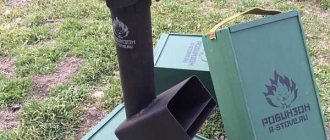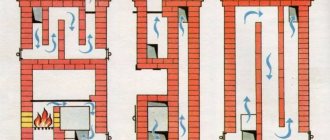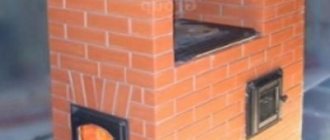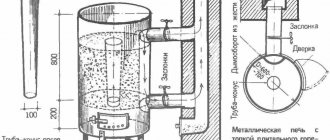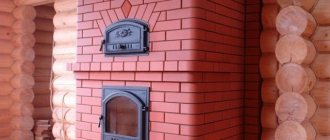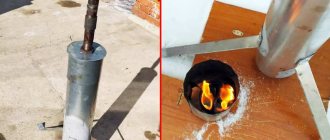Structure of the Buleryan stove and principles of operation
A heater with a high efficiency of about 80%, operating on all types of solid fuel, with the exception of coal. We will look at several models to make a homemade buleryan.
Design and principle of operation of the Buleryan boiler
Let's understand the very structure of this miracle oven and determine the operating principle. In simple human language, a Buleryan stove is a heat-resistant metal structure with a number of pipes that perform natural circulation.
This air heater is designed for heating residential and non-residential premises. Depending on the size and efficiency of the stove, it can heat a small country house, a warehouse or production facility, or a greenhouse.
Buleryan stove
The basic operating principle of the furnace is the design of two chambers. Fuel is placed in one of the chambers. The fuel loading chamber is specially designed so that it contains a small amount of oxygen and the fuel does not ignite completely. If there is a lack of oxygen, firewood or briquettes slowly smolder, forming pyrolysis gas, which burns out in the second of the chambers. Maximum fuel economy - on one tab and high efficiency in comparison with similar devices. This explains why the Buleryan stove is so popular among users. After studying this article, you will be able to make buleryan with your own hands.
Flaws
It is not recommended to load wet wood into the stove. You should not use firewood that produces resins when burning.
The generator gases in the Buleryan burn about 70% in the second furnace. That is why the installation cannot be called perfect.
When installing a chimney, special attention should be paid to its insulation. If this is not done, condensation will be released, which will reduce the performance of the furnace.
The main structural element is the body. Very often it is made of metal. The main source of heat is the boiler. That is why the space around it must be protected. It will be very difficult to protect the space if the buleryan is installed in the corner at the junction of two walls. It is not recommended to install the stove close to a wall. This ban is a big problem for small houses. There should be a maximum distance of 20 cm from the wall to the installation.
If you want to save space, then you will have to cover the walls with metal sheets. Their height must exceed the height of the installation body itself. In this case, you will have to lay basalt insulation between the sheet and the wall. In this case, metal sheets will perform several functions at once:
- protection of walls from heating;
- additional heat source.
It is also worth noting that dust will constantly get into the pipe opening. When the stove burns, a temperature is formed in its channel that is capable of surviving everything in its path. Thus, unpleasant odors will often come from the equipment.
It must be said that during operating conditions, charged ions are formed near the stove, which are capable of attracting small particles of dirt. They can enter the human body. If a person's immunity is weakened, this can lead to illness. In this regard, rooms heated by such a stove must be cleaned and ventilated every day.
If you want to buy such an installation, you need to pay attention to what material the boiler doors are made of. There is a stove with a metal door, it looks beautiful, especially since you can see the fire burning through it
But at the same time, you can only see it when the firewood is burning. In other cases it is useless. Moreover, ovens with such a door have a higher price than usual. Experts do not recommend overpaying, but buying a regular oven with a metal door
There is a stove with a metal door, it looks beautiful, especially since you can see the fire burning through it. But at the same time, you can only see it when the firewood is burning. In other cases it is useless. Moreover, ovens with such a door have a higher price than usual. Experts do not recommend overpaying, but buying a regular oven with a metal door.
Buleryan power calculation video
Buleryan stoves of four types of power, purposes and areas of application:
- Household with hob
- Buleryan household classic
- Industrial boiler Buleryan with power from 60 kW
- Buleryan stove with water circuit
Table for calculating the power of a Buleryan boiler
When choosing a boiler, it is necessary to take into account not just the area of the room, but the cubic capacity - the height of the room is taken into account.
Universal Soldier
Autonomous heating of your premises with wood with minimal costs and maximum output - this is Buleryan or Breneran. Cottage, garage, construction site, workshop, service station, warehouse, greenhouses, workshops, retail and public premises, and most importantly, the properties of Buleryan allow it to be installed even in residential buildings as a constant heating system.
The only nuance that needs to be taken into account is choosing the appropriate size and type of stove so that the room is evenly heated. It is also important to choose the right place for the stove, and to install the chimney responsibly and not forget about cleaning it. Then you can avoid the main problems that Bullerian users face.
Carpentry shops are simply an ideal place for Buleryan - there is plenty of fuel in the form of scraps of wood, which are also perfectly dried.
Design and device features
Buleryan type stoves have a unique design. Two chambers of the boiler, surrounded by tubes on the outside, in which natural convection is formed. Cold air is drawn in from below through the openings of the pipes, and heated air rises from above in the range of 110-120*. For more efficient operation of the stove, it has air and flue gas regulators - damper regulators; with their help, you can achieve the longest smoldering time, up to 5-8 hours continuously. User reviews and videos under the section. The article provides a drawing and assembly diagrams.
Buleryan stove with water circuit
The Buleryan stove with a water circuit is an improved version of a conventional stove, repeating its design, but allowing you to heat several rooms instead of air; this boiler heats water, which circulates through the system. This type of stove has an advantage over the traditional Buleryan boiler.
Buleryan device with a water circuit
The main advantage of this is that the water cools down more slowly, and you can also connect the required number of radiators to the boiler.
Buleryan stove with water circuit
You can assemble a Buleryan stove with a water circuit with your own hands, or buy a factory-made stove.
Scheme of Buleryan with a water circuit
A Buleryan stove with a power of 7-9 kW and a water circuit can heat a small two-story building. You can assemble the stove yourself by adding a water circuit to the buleryan, plugging the heat exchangers and connecting it to the heating system.
Buleryan furnace in production
Burner for working off in a buleryan furnace
As one of the types of fuel, waste automobile and other oils (any automobile oil, frying oil, fuel oil) can be used, this significantly reduces the cost of the heating process. To do this, a pyrolysis burner is mounted to an ordinary classic ready-made Buleryan boiler or to a home-made heater.
pyrolysis burner for Buleryan stove
The consumption in this case is approximately 1.5-2.5 l/hour. The video attached under the article below describes in detail, in diagrams and drawings, the installation of the stove, how you can make such a Buleryan-type stove with your own hands.
Buleryan with hob
Buleryan boiler with a cooking surface
Buleryan boiler with a cooking surface is an undeniable solution. Installed in dachas, small country houses, in the garage. The outer surface of the heater heats up to high temperatures in a short time. You can also make this model of a Buleryan stove with your own hands by welding a sheet of metal with cut out circles on top of the pipe structure.
Buleryan with hob
Step-by-step instruction
Materials:
- Pipes;
- 4mm. 50x50 – 27 m;
- 2mm. 30x20 – 0.76m;
- 2mm. 40x25 – 2 m;
- Diameter 15mm – 0.6m;
- Diameter 95mm. (5mm.) – 1m;
- Steel – 5mm. – 3m2;
- Sheet metal – 100mm. – 0.1m2;
- Wire with a diameter of 10mm – 0.5m;
- Garage hinges – 2 pcs.
Step-by-step instructions for making Buleryan:
- We cut the pipe, which is 27 meters long, into 18 one and a half meter sections, from which we make pipes characteristic of Buleryan (two bends of 120 each).
- 15mm nozzles are welded into 4 of them. tubes (tube length – 15 cm).
- The pipes are folded together in the shape of the future Buleryan and secured by welding. Parts with nozzles are placed two on both sides (later they will act as a blower). Everything is finally boiled down.
- To make the gas afterburning chamber we use 5 mm. steel. We cut out 2 blanks (370x700 mm with a jagged edge 50x60mm to fit the pipe size).
- The parts are welded inside the contour formed by the pipes. Pipes with nozzles should be located in front of the partitions.
- Frame. From the same metal as for the afterburning chamber, we cut plates that will close the gaps between the pipes: 18 pieces for the middle part (400mm x 50mm). 36 pieces for all lower and upper spaces (350mm x 50mm).
- We cover the ends with two 6-carbon plates from the same 5 mm. metal (side 40cm). We make a hole in one of the plates for the chimney. It should be 85 mm in diameter. and located in the afterburning chamber.
- And a hole for the door is cut in the front plate. Approximately 25x25cm. We weld both plates into place.
- The chimney will be a 95 mm pipe, 50 cm long. A valve is installed in the pipe on a wire axis (similar to a throttle valve in a carburetor), with a quarter cut out.
- A pipe frame (40 x 25mm) is made around the perimeter of the door opening.
- We cut out two squares from 10mm metal. The first is 330mm, the second is 246mm. We weld the smaller square with a profiled pipe (40x25), so that it fits into the frame onto the hole for the door (see points 8, 10).
- The blower will be similar to the chimney, only the valve in it will not have a selected quarter. Pipe for 95, 140 m long.
- A 95 mm hole is made in the finished lid, and a blower is welded there.
- Canopies. The door is fixed (by welding) and at a distance of 40 mm from its top and bottom, 2 professional pipes with a length of 380 mm are welded horizontally. Where there will be awnings, the ends of the pipes should protrude 5 cm beyond the hatch. Garage hinges are welded to them.
- Constipation. You can make the lock yourself, or you can order it from a turner. After welding it to the door, the fixing welding is removed.
- All welds are ground.
- You can weld the legs.
Don't be tempted by narrow water pipes. For efficient operation of Buleryan, pipes of 50-70 cm are better suited.
Manufacturing options
Is it possible to make buleryan with your own hands? There are two models to choose from, which option to choose is up to the master, it all depends on the materials available, the experience of craftsmanship and the skills of the master himself. One option is to make a stove from profile pipes, the second is from a gas cylinder.
Buleryan from a profile pipe
Do-it-yourself Buleryan from a profile pipe.
A simple design of a Buleryan stove - a model made from pipes. Buleryan can be made from round pipes or from profile pipes 60*40 mm. The photographs show step by step how to make a Buleryan cauldron with your own hands at home.
Schemes and drawing
Make a Buleryan stove with your own hands: the pipes can be bent or welded at the choice of the master.
The main task is to comply with the general principle of the boiler structure, its operation has not been disrupted, the diagram below shows a boiler made of round pipes, according to the same principle we use profile pipes.
Drawing for making a Buleryan stove
If you adhere to the diagram, then it is assumed that the pipes will be curved. Since not every craftsman can do this process, you can simplify this task and weld the pipes into the desired configuration.
Materials
- Metal sheet, thickness from 4 mm.
- Pipe profile (approximately 3-4 mm) size 6*4 cm - 7 pieces.
- A finished door or a piece of metal sheet.
- For the chimney outlet: pipe d-100-120 mm and a pipe for the damper.
- Door handle.
- Fittings for throttle and damper.
- The seal is heat-resistant in case of self-welding of the door.
- Hinges for doors.
Tools
- Welding + electrodes for it.
- Bulgarian and circles to it.
- Pipe bender (if the structure is curved)
- Electric drill and drills for it.
- Chalk or marker for marking.
- Roulette or ruler.
Step-by-step instruction
Without experience, it will not be easy to work; due to the non-standard shape, it is difficult to make a stove with your own hands, but it is possible. Be prepared to face difficulties, one of which is the number of welds, there will be a lot of them and they must be of high quality.
Profile pipes for assembling Buleryan
Bend 7 pieces of prepared pipes of the required length into the desired configuration according to the diagram and secure them with a welding seam.
Pipe blanks for frame
When you connect all 7 blanks together, you should get a structure of this type.
Buleryan step by step frame assembly
It is necessary to attach grate bars to the pipes from below (either ready-made, or make them yourself from metal blanks).
Frame made of seven blanks
After assembling the frame, we mark strips of metal and attach them pointwise between the pipes, or on top of the pipes, forming a casing.
Casing over pipes
Install the upper partition.
Partition in the Buleryan oven
The length of the partition should not reach the door by about 1/4. Approximately 7-10% of the total surface area will need to be carved out of the plate and welded. The main condition is the tightness of the welding seams! Next, we begin making the back wall. The easiest way is to make a pattern on cardboard or a sheet of thick paper, and then mark it on a sheet of metal.
Back wall of buleryan - blank
We mark the hole for the chimney pipe according to the size of the prepared pipe. Important: the chimney must start in the upper section, which is fenced off. Once ready, weld the wall at the back. Checking the tightness!
Now we come to one of the complex units - the front wall with the door. We cut out the wall itself in the same way as the back one, then we need to cut a hole in it for the door. This hole should be located closer to the grate, just above the grate.
Blank for the front wall
The diameter of the hole must match the size of the door. It is advisable to make it rather large; this will determine what kind of firewood will fit in the firebox. If you make the door yourself, then along the edge of the hole you need to weld a side from fittings curved to the shape of the hole, or a cut from a pipe of a suitable diameter (if the door is round). This side is needed for tightness. The door size will be slightly larger than the prepared hole.
Drawing for making a buleryan door
Along the edges of the door blank, you need to weld one strip of metal and, stepping back, weld a second one; the height of the side should be about 15 mm, so that the side on the front wall, when closing, is between these two plates on the door. To seal, an asbestos cord must be laid between these strips.
Prepared mechanism for the gate
We make a throttle. The damper is approximately 2-2.5 cm in diameter and about 10 cm long. A piece of pipe is best suited for this purpose. From the edge of the pipe, retreating 4-5 cm, we drill two holes, placing them radially. We pass a piece of reinforcement or a rod through the holes; one side will need to be bent - now this will be our throttle handle.
Throttle
Now you need to cut a round piece of metal slightly smaller than the pipe of the body itself - this will be our damper. Having inserted it into the body, we carefully weld it to the fittings. As a result, we get a damper that can be adjusted. The throttle itself now needs to be attached to the door. At the top we make a hole on a quarter of the surface and weld it.
Installation of hinges, shutter and damper for the chimney. The principle of its manufacture is similar to that of the regulator damper. We place the holes radially, pass metal reinforcement through them, then weld the damper and bend it at one edge to get a handle.
Handle to damper
Buleryan long-burning stove from a gas cylinder
Buleryan from a gas cylinder
A simple configuration of a Buleryan stove for self-production, the basis will be a used old gas cylinder. This will be a combustion chamber and will help avoid the additional work of welding the base. This configuration of the Buleryan stove is the most accessible for making at home, without special equipment.
Scheme drawings dimensions
Buleryan’s DIY diagram below provides complete information on the size and complexity of this design.
Material
- The metal is no thinner than 3 mm for the ash pan.
- Cast iron door purchased or prepared in advance.
- Reinforcement or pieces for legs and grate.
- Used gas cylinder.
- For a chimney (pipe blank).
Tools
- Welding + electrodes.
- Grinder or grinder.
- Metal brush.
- For markings, chalk, marker.
- Roulette or ruler.
- Electric drill with drills of the required diameter.
- Pliers, hammer, chisel, metal file.
Step-by-step instruction
Step-by-step diagram for assembling a Buleryan stove
When starting work, first prepare the cylinder. To avoid the cylinder exploding, you need to make sure that there is no gas (residues) in it. A simple method is to fill the container with water to the brim, then drain the water and drain the container.
Drawing for buleryan from a gas cylinder
We mark the holes we need on the cylinder: square for the door, round for the chimney. To make a round hole you need either a cutter, or holes are drilled in a circle and then knocked out with a chisel and hammer. Clean it thoroughly with a file.
The simplest method for making a grate, if you don’t have one ready-made in size. We drill holes of the required diameter in the bottom of the oven, i.e. the cylinder.
Holes for ash pan
We weld a box for ash from the bottom of a sheet of metal, weld a door to this box and this box will act as a blower.
Blower for Buleryans
The doors are purchased, or we make them ourselves.
Doors for the Buleryan oven
We attach a pipe from a piece of pipe of the required diameter to the top of the cylinder. And finally, the last step is to secure the boiler to the legs or stand. The DIY Buleryan stove is ready for use.
Checking the welding machine
The main tool in the manufacture of a furnace is a welding machine. First you need to make sure it is working properly. If you have minimal experience in such work, we recommend that you first practice on training seams. At the final stage of assembling the stove, you will have to scald it around the entire perimeter. You need to be prepared for this. In addition, do not forget to check the metal and pipes for weldability. Materials may need to be replaced.
How to install Buleryan
The main stages of installing a Buleryan heater
- When choosing a place to install the stove, the main thing is to ensure free air convection for better heating of the room.
- The boiler gets very hot during operation, you need to provide a fireproof place for it.
- Under the boiler and in front of the firebox, it is necessary to place a metal sheet on the floor to prevent fire.
- It is recommended to install the stove no closer than 30 cm to the wall and with a distance of at least 60 cm from furniture and other objects.
- if the boiler is located in the corner of the room, then it is advisable to protect the walls with fireproof materials (metal, stone, brick).
- We put the Buleryan stove 20 cm from the floor for natural air convection, for this we mount a stand.
Boiler stand Buleryan
Chimney device
Types of chimney installation: one of them is classic (or traditional). This installation method is used at the initial stage of building a room. The chimney pipe is located vertically and passes through all ceilings.
Types of chimney devices
This method excludes the horizontal arrangement of any nodes. The second method is used at any time, at any stage of the construction of the premises, even after the construction is completely completed. This method is called coaxial; it works more efficiently than the traditional one, as it ensures high-quality removal of combustion products and is less fire hazardous.
Distributing heat throughout the rooms of the house
For the most effective use of the Buleryan stove, in order to heat not one room, but several or the entire house, corrugated pipes can be connected to the heat exchange pipes coming from the stove.
Corrugated pipes are distributed in rooms
The pipes are routed accordingly through the walls of the premises, if necessary through the ceiling. Decorative grilles are installed in the rooms to receive warm air.
Heat distribution between rooms in a large house
However, it should be taken into account that the air leaving the furnace has a fairly high temperature; when passing pipes through partitions and ceilings, the conditions that are provided for the installation of chimneys must be observed. The photo below shows several wiring options.
Heat distribution from a common box
Galvanized or corrugated pipes are used for wiring.
Efficient heat distribution between rooms
Improving the stove design
Buleryan stone finishing
Very often, Buleryan is a design element, especially when it comes to a country house or a chalet-style house.
Brick screen for Buleryan stove
But if we are talking about a homemade device, its aesthetic parameters are of course inferior to products made in production.
Buleryan in the interior of a country house
The most successful way of decoration is to use brick or decorative stone.
Buleryan in the interior
To do this, it is not at all necessary to completely cover the stove with bricks; it will be enough to decorate the walls around the boiler or make a background wall-screen behind which the stove itself will be.
Decoration of the Buleryan stove
The photographs show interesting design options for our heater.
Buleryan boiler in a country house
Installation
When installing the Buleryan heating stove, it is necessary to maintain a distance from the walls, which are provided for by fire safety requirements. This gap is determined based on the material of the walls:
- between the stove and unplastered wooden walls a distance of at least 1000 mm must be maintained;
- the gap between a 25 mm layer of non-combustible plaster and ceramic tiles is 700 mm;
- single brickwork - 500 mm;
- double brickwork - 300 mm.
One of the most important conditions for installing Buleryan is the base (stand under the stove)
It is important that it is non-flammable. For example, you can use 4 rows of bricks that are laid flat
The solution is a clay mixture.
Buleryan stove mounted on a stand
The dimensions of the base should be 30 cm larger than the dimensions of the stove. Also, a metal stand for the Buleryan made of pipes can act as a non-combustible base. Its height is 150-300 mm. Regardless of the method, in front of the furnace itself you need to place a sheet of metal with dimensions: w*d, 500*700 mm.
Particular attention should be paid to the installation of the chimney of the Buleryan stove. The procedure must be carried out according to standard requirements (the only exception is that it must all be well insulated)
The chimney pipe can be made from:
- brick, wall thickness 120 mm;
- concrete with a wall of 60 mm;
- metal
The parameters of the chimney depend on the specific model.
Operating rules
A homemade long-burning boiler, Buleryan, has a simple structure, but to achieve better results in terms of efficiency and long service life, you must adhere to some simple rules:
- Only dry fuel is used for combustion: briquettes, pellets, firewood, wood chips, etc.
- After operating the stove, the ash should not be completely removed each time; its layer protects the bottom from burning.
- Do not use wet firewood; plaque forms on the walls of the boiler and chimney, which reduces the efficiency indicator.
- To achieve maximum efficiency indicators, you need to close the damper throttle and the blower door to enhance the convection process.
Briefly about the main advantages
A small stove of this type can easily heat 100 m2, and a little larger in power and 200–400 m2, while the period between fillings can be about 8–12 hours. You only need to add firewood several times a day and the stove will maintain a constant comfortable temperature .
The rate of firewood combustion depends on the set power, and in many ways also on the type of wood. The room heats up very quickly - in 3 hours the air will be heated to an acceptable temperature. For large areas, several Buleryans are installed or a larger unit is purchased.
This stove is truly very convenient and versatile; it pleases the new owners with big dividends:
- heats a large area;
- uniform heating;
- absence of soot and smoke in the room;
- compact size;
- quick heating of the living area;
- saving firewood;
- easy-to-use door for storing firewood.
What elements should a chimney consist of?
Required elements:
1. Main pipe. Displayed vertically. Pipes can be single-walled (not insulated) and insulated (sandwich). Go to the chimney pipe section2. Tee. Serves for joining the horizontal and vertical sections of the chimney. The use of elbows (corners) for these purposes is not recommended, because During operation of the stove, condensation forms on the walls of the chimney. If you use an elbow, then all the condensate will drain into the oven. To prevent this from happening, use a tee. In addition, the tee will be useful if you need to clean the chimney. Go to the chimney tees section
3. Watering can Installed as a plug on the underside of the tee (now shown upside down for clarity). You can put a hose on the pipe and drain the condensate, for example, into a bucket or sewer. Go to the chimney watering cans section
4. Fungus Protects against precipitation getting into the pipe. Go to the chimney fungi section
5. Fastening Attaches the chimney to the wall. Because pipes have a maximum length of 1 m, therefore, they need to be fastened at least every meter. Go to the chimney fastening section
Additional items
1. Horizontal pipe Connects the furnace pipe and the tee. It is used if the vertical pipe is located at a distance from the stove itself (for example, if the chimney is routed through an external wall). 2. Kryza Serves as the basis for a sealed passage of the chimney through the roof. Layed in a herringbone pattern - the bottom part is laid on the roof covering; the top one is slipped under the covering. A pipe is inserted inside. The distance between the pipe and the roof is covered with comfrey. Go to the chimney roof section 3. Okapnik Covers the distance between the chimney and the roof. Structurally, it is a clamp with a “skirt”. Go to section 4. Deck Covers the lower part of the tee with a watering can. Can only be used with insulated pipes (the photo shows it “upside down” for clarity). Go to the decks section
Tips for use
You will be satisfied with the purchased buleryan if you are careful when using it.
Although sellers in advertising talk about this stove as a universal solid fuel boiler, this is not entirely true. The best fuel in this case is wood. It is best to heat it with non-resinous woods such as acacia, poplar or birch. Briquettes and pellets that you can buy also work well. However, it is better to melt with logs, using briquettes during the combustion process. Never use flammable substances to light the stove.
Before stacking, it is best to dry the firewood on top of the stove, then it will burn more efficiently. A burning period of 8–12 hours is possible only when the firebox is fully loaded.
Never make the chimney pipe shorter than recommended. For successful combustion you need good draft, which is possible with a total chimney height of 5 meters . It is also recommended to assemble the chimney pipe not in the direction of gas movement, but against the movement. This will rid your flooring of resins that leak from the stove openings. If you install the chimney wisely, these resins will return and burn again.
The smoker needs to be checked and cleaned 2 times a year, then you will not have any problems with Buleryan.



